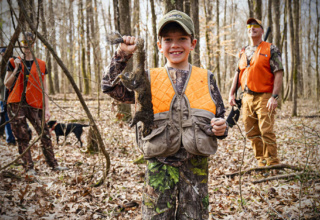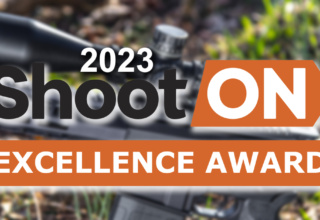Reversing the trend of declining hunter numbers is a responsibility we all share. Here’s how one company is leading the effort.
by Rob Reaser
“Save the whales!”
If you’ve been roaming this earth for a few decades, you probably remember the 1970s rallying cry to protect our aquatic megafauna. Well, the outdoor community has a similar call-to-arms that is no less important for the future of wildlife and their North American habitat.
“Save the hunters!”
Didn’t know hunters needed saving?
After peaking in the early 1980s and remaining relatively stable until 1990, hunting participation in the U.S. began to decline. In 2016, the last year the U.S. Fish & Wildlife Service issued its five-year Participation in Fishing, Hunting, and Wildlife Watching report, an estimated 11.5 million people age 16 and older participated in some form of hunting.
Sounds like a lot, right? But consider this. In 1980, there were an estimated 18 million hunters in the U.S. Not exactly a 50-percent drop in 36 years but getting close. Between 2011 and 2016 alone, hunter participation declined by 16 percent.
When most of us were growing up, hunting didn’t seem to be in any peril. It was part of our family lifestyle and the idea that we would go afield with a gun or bow was the natural course of things.

Like most of you reading this, I started small, learning to hunt squirrels at the knee of my father and grandfather. I can still remember my first squirrel.
Grampa had taken me up on the hill above our family camp. The ridge widened out to a charming flat heavy with hickory, oak, and a smattering of pines. Grampa wasn’t the run-and-gun type of hunter, so we sat on a log about ten yards from a hickory tree. I could see nothing in the bare, gray tangle of branches overhead, but Grampa insisted we sit and wait. About 15 minutes passed before he nudged me with his elbow. I’m sure I was staring off somewhere else or was otherwise distracted, but when I saw that bushy tail flickering against the blue autumn sky, the excitement nearly overwhelmed me.
Grampa slowly passed me his .410 break-action shotgun, the same one he had used for as long as I could remember (which wasn’t long) and had continued to use until he could no longer hunt.
“Wait until he comes down closer,” he whispered.
I was breathing hard and fast, the barrel of the single-shot wavering all around as I tried to track the gray squirrel while it skittered down the shagbark trunk. When it stopped on a limb with its tail curled gracefully along its back, Grampa said, “Go ahead.”
I think I pulled the trigger as soon as I heard the word, “Go…”
Most of us can relate to the deafening silence that followed—that post-shot stupor when ears are ringing, adrenaline is pumping, and a fuzzy white vision freezes the moment.
When I got my senses back, Grampa clapped me on the back.
“You got it,” he said in his soft voice.
The thrill of that first successful hunt fueled a fire that has never burned out, and most of you probably are no different. Hunting is a way of life we were born into and is something we take for granted. While some may look at those declining hunter participation numbers and think, “Oh, well…more space and less competition for me,” it is important to understand that this is not the big picture.
In spite of the great strides we have made in wildlife management and in the increased opportunities to hunt over the last century, all of it threatens to crumble for the simple reason that the hunting community is contracting at an alarming rate. This is a problem because hunters and shooters are largely responsible for wildlife management in the form of the funding they provide. The federal tax we pay on firearms, ammunition, and archery equipment through the Federal Aid in Wildlife Restoration Act combined with state revenues generated from the sale of hunting licenses supply the funds to ensure sustainable wildlife habitat and the public land management we rely on. Without hunters supplying these funds, we all suffer in the long run. This is why the declining trend in hunter participation is so important to reverse.
Efforts are afoot to recruit new hunters, but the challenges are significant—and even that may be an understatement.
We once had a culture in this country where hunting and recreational shooting was an accepted norm. Young people today, though, face serious pressure to abandon those ideals and activities. From the national political class deriding our heritage and our lifestyle to local schools instilling a sense of absolute wrongness and vilifying of firearms to the ever-increasing restrictions on private land access for recreational hunting, it’s no surprise that the life many of us grew into is now a pursuit poisoned with ideological rhetoric and a continuing onslaught of cultural challenges.
The result, though, is the quiet, steady suppression of a lifestyle and a heritage we know to be rewarding, fulfilling, and even life-changing.
Fortunately, there are those among us who are working hard to make a positive change and to bring new hunters into our ranks. A shining example is the Squirrel Master Classic.
For the last seven years, GAMO Outdoor USA, manufacturer of precision airguns, has sponsored this exciting event. Spearheaded by Buckmasters‘ own Jackie Bushman, the Squirrel Master Classic is an annual happening that takes place just outside of Montgomery, Alabama, each February. The goal is multi-fold—introduce kids to hunting, raise awareness of the need to recruit new hunters among both youths and adults, and showcase airguns as an effective, cost-conscious “on-ramp” for beginners to engage the shooting and hunting sports.
The idea is a simple one and one that has proven itself time and time again. Take a kid hunting, give them the time and attention to help them see and experience the natural world from the hunter’s perspective, and make the experience a positive one. If a mentoring hunter can do this, the chance that the youngster will grow his or her skills and become an active hunter in adult life is good.
Squirrel hunting is the ideal way to light the fire for most first-time hunters. Unlike big-game hunting, the low pressure and minimal hunting skills required to be successful is perfectly suited for beginners.
For the Squirrel Master Classic, everyone hunts “Alabama-style.” Trained squirrel dogs are set loose along the mixed hardwood hills and creek bottoms to locate trees with squirrels in them. Once the dogs signal an active tree, the hunters sprint in. Sometimes the squirrel is holding tight in the fork of a limb, sometimes they’re holed up in a nest.
In this part of the country, thick vines dangle from trees like tangled spaghetti. When Mr. Bushytail is holding close to the bark and out of shooting sight, the hunters grab vines and start yanking. That’s usually enough to get the squirrels rattled and moving onto an open limb to present a shot. This form of hunting delivers quick results when using a shotgun, but with pellet rifles, such as the GAMO Swarm Magnum 10X Gen2s used for this event, a clear eye and a ready trigger finger are essential.
To meet the event objectives, the Squirrel Master Classic divides participants into teams. Each team is comprised of a television hunting personality, a kid selected from Alabama’s 4-H SAFE Shooting Sports Program, a national outdoor writer, a squirrel dog or two, and the dogs’ handler. This team make-up puts veteran hunters in a mentoring position to help the young 4-H shooters experience the excitement and fun of hunting.
I had the pleasure of being on The Choice team, hunting for two days with that most-loved hunting couple, Ralph and Vicki Cianciarulo, their son RJ and Case Kempfer (hosts of the upcoming reality show Moving Forward), and 18-year-old 4-H member Ethan Hughes.
Ethan became involved in 4-H because of his interest in raising chickens. Unlike many 4-H participants, he was already familiar with shooting, having been brought up in the hunting lifestyle. As with many of us, Ethan started out with a Red Ryder BB gun, which required the stock to be shortened for him to shoot it. Eventually, he started participating in the organization’s shotgun and archery programs before moving up to become a 4-H National Shooting Sports Ambassador. Now 18 years old, Ethan will graduate high school this spring and is looking forward to attending Auburn University in the fall.
Not all youth, though, are exposed to shooting and hunting at an early age. In fact, few among our ranks woke up one morning and said, “I’m going to go hunting.” Family got us started without us giving conscious thought about doing it. It was just “what we did.”
But put yourself in the shoes of a kid or an adult—someone who hears others talking about hunting at school or in the workplace. Maybe they would like to see what it is all about. Perhaps they would even like to try it themselves. Where do they start?
We take for granted the shooting skills we’ve developed, the nature of game animals, and how to go afield in their pursuit. We know what kind of clothing to wear, what gear we need for a particular hunt, and, yes, what to do with a bird or animal once we’ve harvested it. How do you field dress it? How do you prepare it for the table?
For someone who has never hunted before, these can be insurmountable challenges—challenges enough that they may never even bother in spite of a desire to give it a try. This is where we, as veteran hunters, have an obligation to step up.
Many state wildlife departments have initiated hunting mentor programs designed to bring youth into the hunting ranks, but more active volunteer participation from seasoned hunters like us is needed. Further, organized mentoring programs aren’t the only means of swelling our numbers. This is something we can do one-on-one by asking a neighbor kid, a co-worker, or a non-hunting family member or friend if they would like to grab an airgun and hit the woods some fair autumn afternoon.
At last year’s Squirrel Master Classic, I had the chance to talk with Chuck Sykes, Director of Alabama’s Wildlife and Freshwater Fisheries Division. As we were walking back to our trucks after the second morning’s hunt, Chuck discussed his state’s fledgling Adult Mentored Hunt program and the rewards of established hunters taking time to bring a first-timer into our sport.
The Adult Mentored Hunt program was developed to give new or limited-experience hunters the benefit of hunting one-on-one with a seasoned mentor. In the program, participants learn firearm safety, equipment needs, scouting and hunting tactics, as well as how to clean and cook wild game.
The lessons here are many…for all of us. Hunting is a way of life, for sure. It is also a heritage we are blessed with here in America but one that may not continue if we fail to pass it on by giving our time and experience to others. After all, someone did that for you and me in the beginning.
“The Squirrel Master Classic is an event everyone greatly enjoys,” said GAMO President of Marketing Andy Carroll, “from the seasoned hunters to the 4-H participants—most of whom have never before hunted. The reward is to see the excitement and the smiles of these youngsters and to know that their experience here will be a spark they’ll carry forward to ensure our hunting and shooting heritage will be around for future generations.”
GAMO’s Swarm Magnum .22 Air Rifle
For this year’s Squirrel Master Classic, GAMO provided all hunters with the new Swarm Magnum 10X Gen2 air rifles—exactly the kind of rifle you want when you’re after squirrels dancing in the treetops or rabbits feeding along field edges.
The saving grace for our squirrel hunt was the rifle’s second-generation 10X Quick-Shot technology. This is a ten-pellet magazine that loads into the top of the rifle. Simply shoot and re-cock and the magazine automatically advances the next round. No need to manually reload between shots.
The 10X Gen2 system features a horizontal magazine versus the previous vertical magazine. This new design, first introduced on last year’s Swarm Fusion 10X Gen2 model, has a lower profile that allows for the use of open sights. Although the Swarm Magnum comes with a 3-9X scope, it also includes adjustable rear sights with fiber optics and a fiber optic front sight, so if you prefer to shoot with open sights, you’re good to go.
Another cool features of the new generation 10X magazine is that it is inertia-fed. A spring mechanism built into the magazine only advances upon recoil. This prevents the shooter from accidentally double-feeding pellets. Very slick, and very effective.
As for ergonomics, the Swarm Magnum’s stock doesn’t get much better. Constructed from an all-weather molded polymer, it features a comfortable thumbhole-style pistol grip with no-slip texturing on the grip and forend, a recoil-absorbing butt pad, and a comfortable cheek weld. I found the two-stage adjustable trigger to be remarkably smooth and the automatic cocking safety lever located forward of the trigger easy to use.
For more info on GAMO airguns, visit GAMOUSA.com.


























